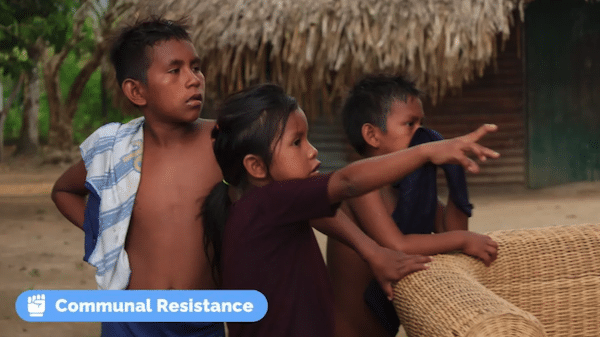Early in the last decade a set of communities along the Cataniapo River started to organize themselves to protect the river’s ecosystem and bolster their agricultural and handicraft production. A few years later, in response to Chávez’s call to build socialist communes, 15 communal councils in the area came together to form the Río Cataniapo Commune.
Today, approximately 1500 people participate in the commune. They come from various ethnic backgrounds, but the majority identify as Indigenous and some still practice common ownership of the land. The backbone of the commune’s food economy is yuca, which is used for making casabe [flatbread], mañoco [flour], and catara [spicy sauce]. The yuca is grown with traditional methods in small “conuco” plots alongside sugarcane, auyama [pumpkin], topocho [small plantain], corn, and cacao. A growing handicraft economy focuses on producing mamure[vine] baskets and furniture.
The commune includes Indigenous communities with people from the Huo̧ttö̧ja̧, Kurripako, Baré, Jivi, and Yeral nations, alongside smaller non-indigenous or “criollo” communities. In Part I of this three-part series, members of Río Cataniapo discussed the commune’s roots in traditional Indigenous organization. Here, in Part II, we delve into the culture and organization of the Huo̧ttö̧ja̧ community in the Río Cataniapo Comune. In the final part, we will explore the economy and the impact of the U.S. blockade on the commune’s daily life.
[Note: In various interviews, participants spoke in their Indigenous language, relying on community translators to render their statements in Spanish.]
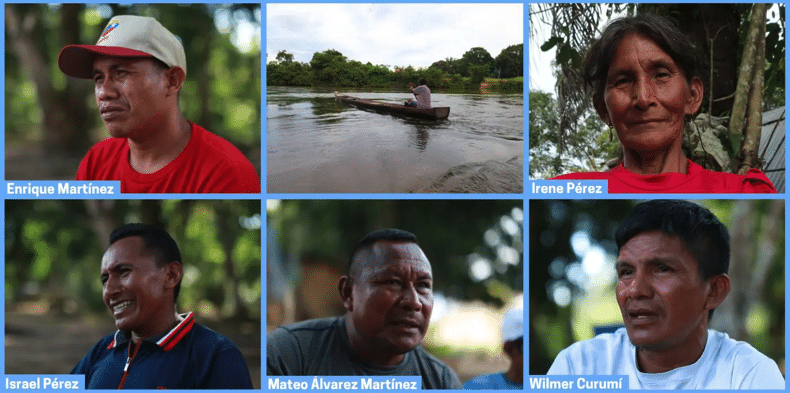
Enrique Martínez, of the 5 de Julio-Las Pavas Communal Council, is head of an UBCH | Irene Pérez, of the 5 de Julio-Las Pavas Communal Council, is an artisan and campesina | Israel Pérez is a member of the 5 de Julio-Las Pavas Communal Council | Mateo Álvarez Martínez, of the 5 de Julio-Las Pavas Communal Council, is a schoolteacher | Wilmer Curumí is a member of the 5 de Julio-Las Pavas Communal Council, where he serves as Productive Economy Spokesperson. (Photo: Rome Arrieche)
The Huo̧ttö̧ja̧ people, culture and evolving organization
The Huo̧ttö̧ja̧ comprise the largest Indigenous group in the Río Cataniapo Commune, where they maintain their language and rely on the traditional leadership roles of cacique and shaman. Their origin story, passed from one generation to the next, explains the richness of the land they inhabit.
ASSEMBLY-BASED ORGANIZATION AND INDIGENOUS LEADERSHIP ROLES
Wilmer Curumí: When we face an important decision or a problem, the cacique [traditional authority] convenes an assembly where men and women, youth, and elders participate. He may propose a solution and, if there is consensus, that becomes our course of action.
However, if disagreements arise, deliberation continues until we reach a resolution.
Because deliberation is part and parcel of our identity, when government initiatives such as consultations come around, the process flows easily: we can quickly identify the key issues our community needs to address. Self-government is embedded in our daily lives.
Israel Pérez: Today, the figure of the capitán is present in almost every Indigenous community; they serve as mediators. However, the position of capitán originated in the 4th Republic [1958-98]. In some communities, the capitán came to supplant the cacique; in others, they coexist and have a positive synergy; and in still others, the capitán and the cacique are embodied in the same person.
In earlier Huo̧ttö̧ja̧ organizational forms, there were three power centers: the cacique, who held political authority; the Shaman, who had vast knowledge about crop cycles and healing; and the Council of Elders.
Enrique Martínez: The Council of Elders is where the most complex decisions were made, generally gathering elders from several churuatas [collective dwellings, but also refers to a whole community].
Mateo Álvarez Martínez: Traditionally, the cacique was the ultimate authority on social and political matters, but he was never alone. He had an advisor, a chanting man, and a messenger. The messenger would visit other churuatas to convene a Council of Elders when necessary. Nowadays, the capitán assumes some of the roles previously held by the cacique.
In the realm of spirituality, the shaman served as a healer; he was knowledgeable about lunar cycles and crops and would also guide the community in caring for sacred spaces and nature.
Ultimately our communities were—and still are—integrated into the assembly, be it in a deliberative or informative manner.
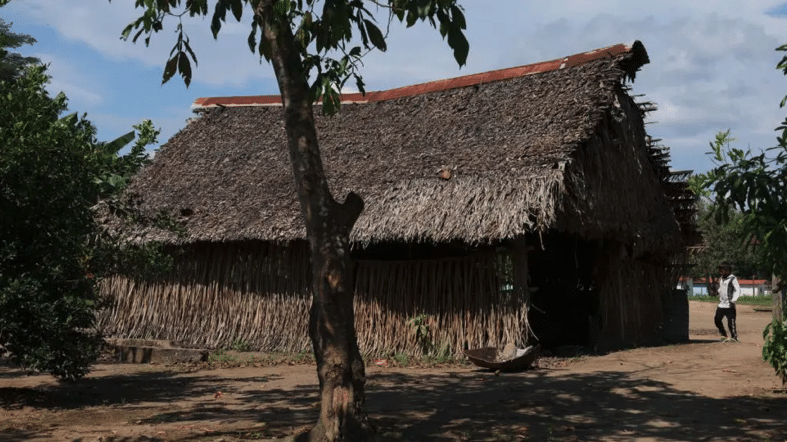
Structure covered with palm leaves in 5 de Julio-Las Pavas Communal Council. (Photo: Rome Arrieche)
CULTURE AND LANGUAGE
Mateo Álvarez Martínez: Our origin story goes as follows: We, the Huo̧ttö̧ja̧ people, were born out of a large god known as “Mereya Anamei.” Mereya Anamei created the first man and the first woman with his great power. The first person was named “Puruna,” and he was allowed to see Mereya Anamei, but only in a spiritual sense.
In his visions, Puruna beheld a man and a woman adorned with feather crowns, necklaces, and painted symbols on their faces. After Puruna donned the crown, necklaces, and painted his body, Mereya Anamei authorized him—and us—to be called Huo̧ttö̧ja̧.
Then there’s our story of the “Tree of Life,” accounting for features of our territory, which has been passed down from generation to generation.
The tale goes as follows: Mereya Anamei, a deity, saw a colossal tree bearing all kinds of fruits, including copoazú, temare, and guama [all Amazonian fruits]. Thousands of creatures dwelled on the tree. Mereya Anamei claimed the tree [and wanted to cut it down], but some people were displeased and consulted Wahari, a warrior, who then spoke to Waicuni and his younger brother Rwayey. Together, they managed to protect the people: they ensured the tree would fall in our direction—toward the West [present-day Venezuela]. The tree stump remains; we call it Autana [the toponym used for a tepuy rock formation in Amazonas state].
Now, our land is abundant because the tree left its gifts. This is the land where Huo̧ttö̧ja̧ is spoken.
Enrique Martínez: For us, the language is an ancestral right; we speak Huo̧ttö̧ja̧ to carry out our daily affairs, and our culture is inscribed in it. Some criticize us because there are people in our communities who have a hard time speaking Spanish, but we take pride in this fact because it has a corollary: our language is alive and well.
We also work hard so that our schools will teach our kids in Huo̧ttö̧ja̧ and, when possible, the teachers are from the community. We also have language manuals, which are important for the preservation of our language.
However, we haven’t been able to preserve other important traditions, particularly the attire. Some of us may dress in the cayuco [traditional Indigenous garment] on special occasions, but the process of transculturalization is visible: today and most days there is no difference between what you wear [pointing at the interviewers] and what I wear.
Wilmer Curumí: The 21st century has been hard on our ways and traditions, particularly in the realm of rituals: dances such as the “Rere” or “Warime” are very rarely practiced: most shamans are no longer with us and the occidental cosmovision has penetrated our life in many different ways.
There are, however, important traditions that we maintain; we resolve our problems in assembly, we plan for the year’s production and crops together, and we care for the river and the forest communally.
Irene Pérez: Our way of living is far more communitarian than the sabari [non-indigenous] way of life: there must not be a single person in our community who goes to bed hungry, for it would be as if the whole community went to bed hungry. Then there is another thing that is very much communal for us Huo̧ttö̧ja̧: child-rearing. A child is not the exclusive responsibility of the mother; the kid will be cared for by the whole community.
Lastly, one of the important traditions we still maintain is our ancestral knowledge of healing plants. Over the years, my father has become a keeper of this wisdom passed through generations. People from the community often seek his advice when they are sick.
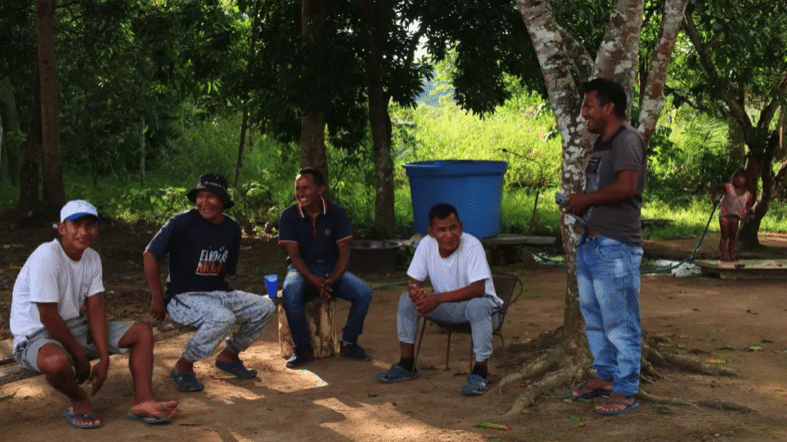
5 de Julio-Las Pavas Communal Council. (Photo: Rome Arrieche)
The Bolivarian Process and Indigenous peoples
Article 260 of the 1999 Bolivarian Constitution recognizes Indigenous peoples’ right to autonomous self-governance and provides for Special Indigenous Jurisdictions. In this way, the Bolivarian Process laid out a more favorable and just legal framework for the Indigenous peoples of Venezuela.
THE CONSTITUTION
Enrique Martínez: The 1999 Constitution made significant strides in promoting our rights. It recognizes Indigenous peoples’ autonomy and collective land ownership while safeguarding Indigenous languages, cultural expressions, and traditions. The constitution also established that there would be three Indigenous representatives in the National Assembly.
Before Chávez, we did not exist: we had no representation, no jurisdiction, no voice. The Bolivarian Revolution came to change that, and that’s why our electoral centers go red [Chavista] on election day. We have no doubt: if the Right came into power, they would strip us of our cultural, political, and social rights, including the right of our children to study in our native tongue.
In school, our children learn Spanish, but they also study in Jivi, Kurripako, or Huo̧ttö̧ja̧. Do you think this would be tolerated by a non-Chavista government?
INDIGENOUS JURISDICTION
Israel Pérez: Articles 119 and 260 of the Bolivarian constitution establish that Indigenous communities can administer justice in their territories. In Amazonas state, there are five “Special Indigenous Jurisdictions,” and one of them is here, in Las Pavas.
Special Indigenous Jurisdictions deal with communal governance, conflict resolution, and justice within an Indigenous community. For example, an Indigenous court may resolve disputes, handle marriage and property issues, or manage resources in accordance with traditional practices.
Our Indigenous Jurisdiction was established in 2018, following a situation in which some members of our community were detained by the National Guard while hunting; they were accused of possessing firearms without a license. These young men were going to be tried in a non-Indigenous court, and that was unacceptable to us. That’s when we organized ourselves, turned to the Constitution, and were finally able to establish our Indigenous jurisdiction.
Here in Las Pavas, justice is exercised by and for the community, with the cacique-capitán [in Las Pavas, it’s the same person] serving as the legitimate authority to issue a verdict.
Since creating our Indigenous Jurisdiction, we have been able to expel irregular groups from the territory, claim vacant lands for community use, and resolve other internal issues through dialogue. The Indigenous Jurisdiction has proven to be a useful tool for self-government.
Unlike Western justice, which is punitive and delivers the final verdict in writing, our justice system is oral and focuses on mediation rather than punishment. The impact of our Indigenous jurisdiction has been enormous because peace and harmony in Las Pavas are defined on our terms: when matters pertain exclusively to Las Pavas, no external agent can intervene or punish members of our community.
The establishment of the Special Indigenous Jurisdictions is a significant achievement of the Bolivarian Revolution, earning recognition from the Inter-American Court of Human Rights for its pivotal role in safeguarding the Cataniapo River.
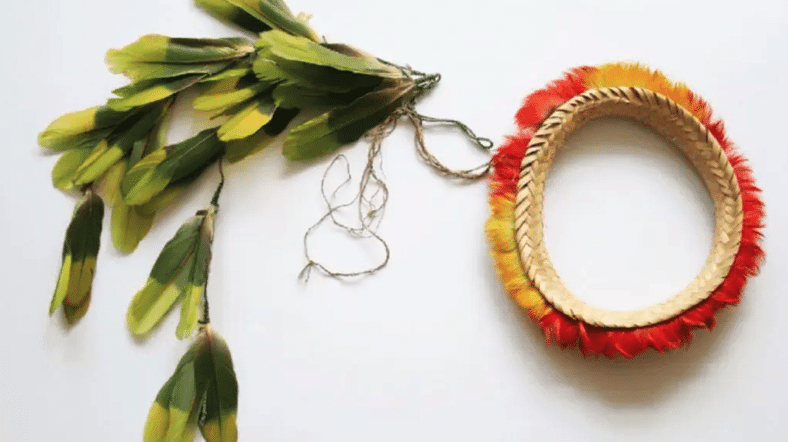
Huo̧ttö̧ja̧ crown (Photo: Archives)
THE COMMUNE
Wilmer Curumí: We owe much to Hugo Chávez. One of his most significant contributions is the commune. It coincides with our ancestral forms of organization and provides a way for organized communities to access state resources.
The commune is now a critical element in our fight for reconstruction and full justice.

Autana, the stump of the Tree of Life (Photo: Archives)

